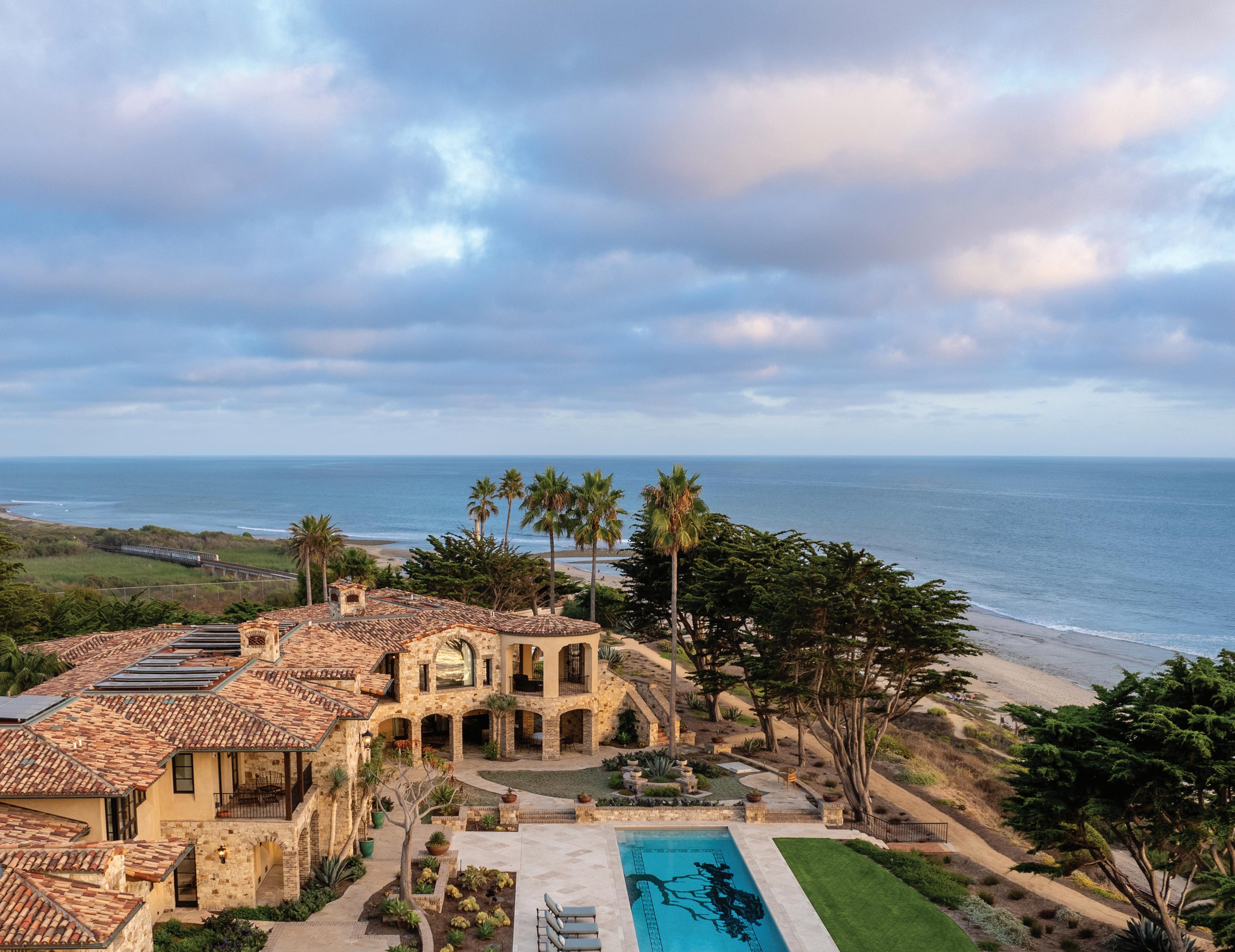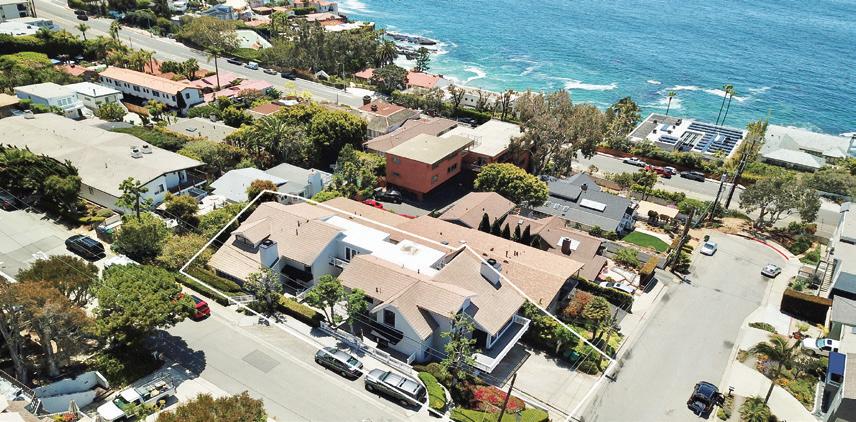With captivating white water ocean views that stretch as far as the eye can see, this 4-bedroom plus den, 4.5bathroom haven is designed to elevate your lifestyle. Step inside and be greeted by the seamless fusion of modern elegance and timeless charm. In addition to a thoughtfully integrated elevator, the spacious living areas create an airy and inviting ambiance throughout and Pacific Ocean views can be had from the expansive multi-level decks and balconies. The heart of this home is the chef's dream kitchen adorned with top-of-the-line Thermador appliances. Each bedroom boasts an en-suite bathroom for unparalleled comfort and privacy. The primary suite is a serene sanctuary, complete with a spa-like bathroom and patio space that frames panoramic ocean vistas. The sprawling driveway is capable of accommodating more than six vehicles, a rarity in this coveted area.
PROPERTY: 1060 Van Dyke, Laguna Beach
OFFERING PRICE: $6,195,000
AGENT INFO: Carter Kaufman | 949.294.6411 carter@carterkaufman.com | carterkaufman.com
Vintage Meets Modern
BLEND RETRO-INSPIRED AND CONTEMPORARY DECOR FOR TIMELESS ELEGANCE.
By TANYA A. YACINA / COURTESY OF LAGUNA BEACH MAGAZINE
Mixing modern design pieces with retro or vintage-inspired items can create a unique aesthetic in a home. Michael Fullen, founding principal of Fullen Enany Design Group, says spaces should reflect the owner’s style and, at the same time, have a soul. Mixing old with new adds character and a bit of history, regardless of overall style.
“Most of us have treasured items from our past. I like to use those items as part of the home’s interior design,” Fullen says. “This could be anything from a kid’s baseball glove, a collection of vintage items or
“Since we all retreated back to our own homes in early 2020, I think we all wanted our home to not only function properly for us, but also make us feel comfortable and relaxed,” he notes. “Adding a little bit of character and warmth helps to achieve that feeling and sense of comfort.”
Fullen says that when his team works on a project, they get to know a lot about the owners and their families, try to uncover personal interests and assess the client’s current decor. Along the way, he “collects” items that play to those interests and can be used as decorative accessories or furnishings.
“It is very easy to make a home feel collected over time if we delve into the interests of those that … live there,” Fullen says. “Consider using a vintage rug in a contemporary
an heirloom piece of furniture. [Incorporating] items from someone’s past [helps to] personalize … the spaces.”
According to Fullen, experts in the design world have been mixing traditional decor with contemporary items for many years, but the idea has more recently caught the eye of mainstream retailers. Now, reproduction architectural etchings, aged rugs, Roman statue fragments, distressed leathers and even French garden plans are just some of the examples of trending items that can help you achieve this aesthetic.
room setting. Pull out old black-and-white photos and create a collection, or mix art from different periods and styles and hang salon style.”
He also recommends visiting vintage stores or antique shops to see what catches your eye; it doesn’t have to be a major investment to make a statement. Pair a contemporary house designed using glass and steel with an antique console in the entryway, and it would not look out of place. Meanwhile, he adds, a Spanish Revival home could be completely outfitted in contemporary furnishings.
“Mixing old and new has no specific rules—use what you love,” Fullen says. “It’s your personal space and it should reflect each of the family members [in its design and decor].”
Vintage and modern pieces can be used together within the same room.
Spaces that mix old and new pieces should reflect the owners' style and personality.
ECO-CONSCIOUS HOMES
NATURAL MATERIALS ARE TAKING OVER LOCAL DWELLINGS WITH SUSTAINABLE STYLE.
BY ASHLEY PROBST / COURTESY OF NEWPORT BEACH MAGAZINE
As consumers continue to call for eco-conscious practices, it makes sense that this sustainable approach would make its way into the place where we spend the most time: our homes.
Genevieve Chambliss, owner of Newport Beach-based interior design studio Vieve Interiors, speculates that this increase of interest is based on more visibility, availability and a collective shift in our sociability.
“We’re spending so much more time in our house,” she notes. “… [People are] being a little bit more conscious about the things that we’re putting around us that we have to look at, touch [and] use every day.”
One of the biggest trends that interior designers like Chambliss have seen are homeowners who are moving away from synthetics and instead opting for natural materials and fabrics like bamboo, cork, cotton or rattan.
“I think that natural materials have always been a big draw in the beach communities,” Chambliss says, noting that Newport-esque furnishings and decor have a distinctly coastal vibe.
Some popular pieces among local residents include live-edge tables, woven rugs and cabinets made of sustainable wood.
An example of the latter would be the teak and white oak used by local designer Erica Bryen, owner of her eponymous design studio, in a recent Newport Beach project. She also utilized natural materials like woven seagrass and beaded cocoa shells for different light fixtures, linen for window shades, rattan barstools and more.
“I’m definitely a person that cares about layers and one of the ways to get that is with natural materials,” Bryen says. “… And I think it can be in all aspects of design.”
One thing that’s often on homeowners’ minds is the cost, since eco-friendly alternatives are known for being expensive.
“[It’s about] sharing with the client what the value is in that and the durability factor … [and having] less need for maintenance,” Chambliss says. “… Sometimes [they need to] spend a little more to get something that they’re not going to have to replace in a couple years.”
Bryen also points to furniture and decor made of synthetic leather, which often peels and falls apart because it’s made of polyurethane. “You’re saving and you’re getting this cheap [product], … but you’re also just breathing in something that’s
made of horrible stuff all day long,” she says. “… Quality is what you pay for.”
It’s also worth it to know that when you focus on environmentally friendly materials and ethical sourcing, you’re supporting a sustainable business model and the future of this industry.
Chambliss also aligns these principles with her home designs by utilizing repurposed materials whenever possible, which helps reduce the environmental impact of manufacturing new products. One example is an ongoing project that will incorporate reclaimed white oak and may also include outdoor furniture that’s constructed out of recycled metal.
“Another thing that I always think about is sourcing locally and using decor or artwork from local artists or handmade stuff,” she says. “That is very popular and definitely a sustainable way to go instead of importing or shipping things, [which] … then incurs the cost on the environment from all of that travel.”
If you’ve set an intention to make your home more eco-conscious, locally sourced natural materials are an excellent way to weave these values into your sustainable space.
Interior designer Erica Bryen incorporates natural materials like teak, woven seagrass and linen for sustainable style.



















































































































